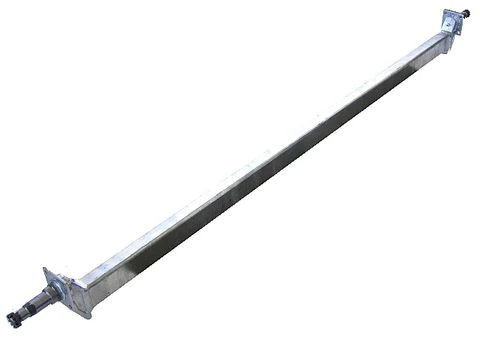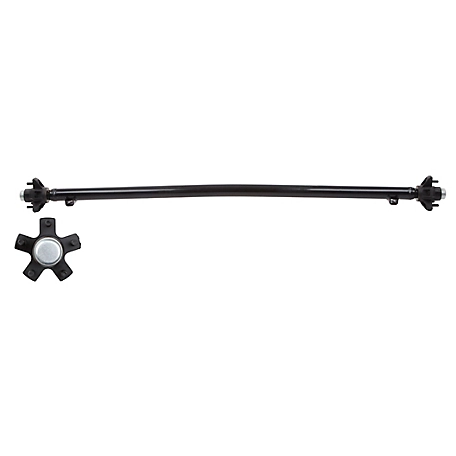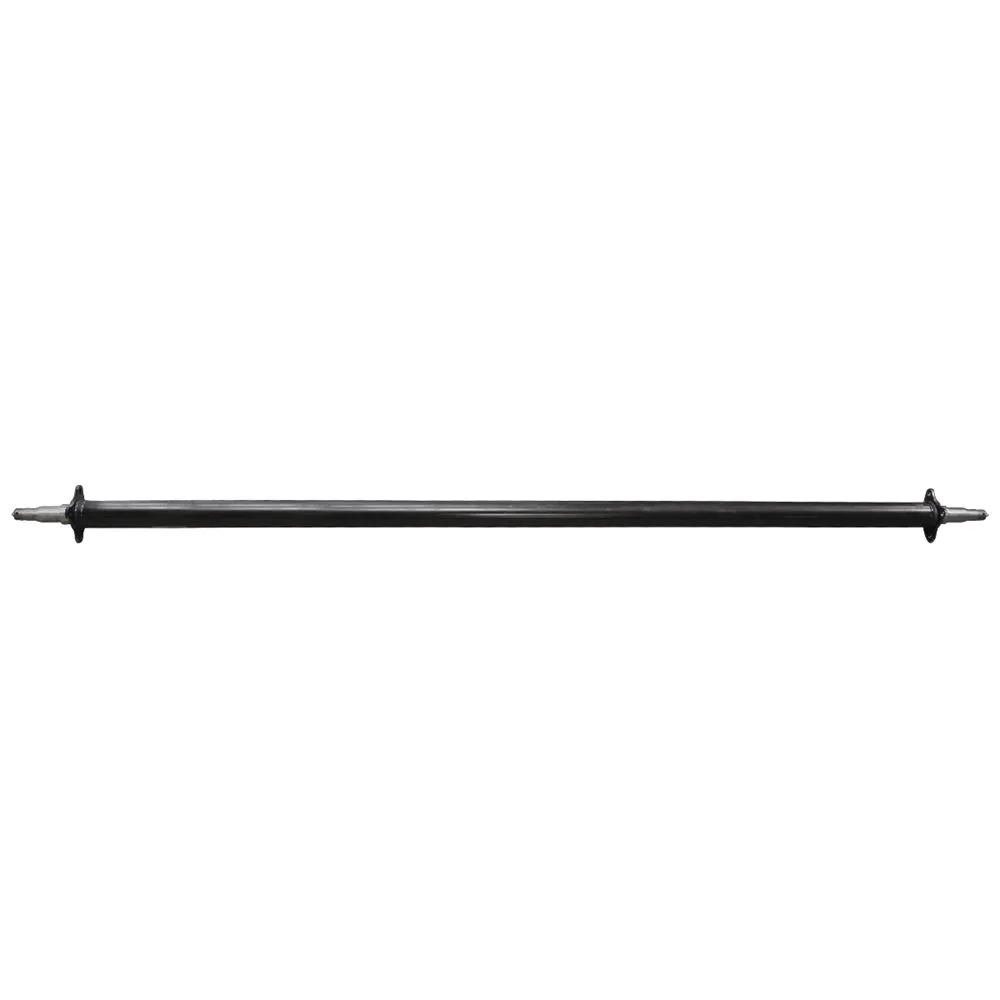Product Description
Axle – British Series
| Model |
Capacity | Brake | Track | Distance of Spring | Distance of Brake Chamber | Axle tube | Wheel Fixing | Bearing | Total Length | Weight | Recommend wheel | ||
| T | mm | mm | mm | mm | mm | Stud | P.C.D. | C.B.D. | mm | kg | |||
| UTB12SB07B2 | 12 | 420×180 | – | ≤450 | – | 150 | 8-M20x1.5 JAP |
285 | 221 | 33213/ 218248 |
350 | 7.5-20 | |
| UTB12RA07B2 | 12 | 420×180 | – | ≤450 | – | 127 X18 |
8-M20x1.5 JAP |
285 | 221 | 33213/ 218248 |
340 | 7.5-20 | |
| UTB13SB03B2 | 13 | 420×180 | ≤450 | – | 150 x14 |
10-M22x1.5 ISO |
335 | 281 | 33213/ 218248 |
350 | 20 | ||
| UTB13SB10B2 | 13 | 420×180 | ≤450 | – | 150 x14 |
10-7/8″ BSF |
335 | 281 | 33213/ 218248 |
350 | 20 | ||
| UTB16SB10B4 | 16 | 420×220 | ≤450 | – | 150 x16 |
10-7/8″ BSF |
335 | 281 | 218248/ 220149 |
420 | 20 | ||
| UTB16SB03B4 | 16 | 420×220 | ≤450 | – | 150 x16 |
10-M22x1.5 ISO |
335 | 281 | 218248/ 220149 |
420 | 20 | ||
| UTB16RA03B4 | 16 | 420×220 | ≤450 | – | 127 X25 |
10-M22x1.5 ISO |
335 | 281 | 218248/ 220149 |
430 | 20 | ||
| UTB18SB05B4 | 18 | 420×220 | ≤450 | – | 150 x18 |
10-M24x1.5 ISO |
335 | 281 | 218248/ 220149 |
450 | 20 | ||
| UTB20SB05B4 | 20 | 420×220 | ≤450 | – | 150 x20 |
10-M24x1.5 ISO |
335 | 281 | 220149/ 33571 |
475 | 20 | ||
2.Why Choose UT Trailer?
ZheJiang UT Trailer Parts Co., Ltd., is a professional manufacturer of semi trailer’s spare parts. It possesses production buildings of more than 12000 meter square, and senior and intermediate staffs more than 60 technicians’ team. Our products are strictly been produced and examed by ISO9001: 2000 International Quality Management System.
We’ve been exploited overseas market continuously, and established sale and after service net spot in nation scope. It is our CZPT pursuit that “the first class products, reasonable price, the perfect after service”.
3.How to find us?
| Contact Person | Polly Yang |
| Mobile | 15966650560 |
| Add: | Zhudian Industrial Zone, Xihu (West Lake) Dis. District, HangZhou City, ZheJiang Province, China |
| Web: | uttrailerparts |
| Type: | Axle |
|---|---|
| Certification: | ISO/TS16949, CCC, ISO, CE, ISO9001 |
| Loading Weight: | 16t, 12t, 18t, 20t |
| ABS: | With ABS |
| Axle Number: | 1 |
| Tire Number: | 4 |
| Samples: |
US$ 0/Piece
1 Piece(Min.Order) | |
|---|
| Customization: |
Available
| Customized Request |
|---|

Are there specific challenges or maintenance practices for boat trailer axles?
Boat trailer axles come with unique challenges and maintenance requirements due to their exposure to marine environments. Here are some specific considerations:
- Corrosion: Exposure to saltwater can lead to accelerated corrosion. Regularly rinsing the axles, especially after launching, helps mitigate this issue. Additionally, choosing galvanized or aluminum axles provides better resistance to corrosion.
- Bearing Maintenance: Boat trailer axles often require more frequent bearing inspections and maintenance due to water exposure. Greasing the bearings before and after each trip is essential to prevent water intrusion and prolong bearing life.
- Seals and Gaskets: Ensure that seals and gaskets are in good condition to prevent water from entering the hubs. Replace them if they show signs of wear or damage.
- Proper Storage: Storing the boat trailer properly, preferably in a dry, covered area, can significantly extend the life of the axles and other components.
- Regular Inspections: Periodic inspections of the entire axle assembly, including brakes, hubs, and wiring, are crucial for early detection of issues that could lead to axle failure.
- Tire Maintenance: Proper tire care is essential. Check tire pressure, tread wear, and sidewall damage regularly, as underwater loading can stress trailer tires.
- Brake System Checks: Ensure that the brake system is functioning correctly, especially if the trailer has brakes. Saltwater exposure can affect brake components.
- Electrical System: Check and protect the electrical components to prevent corrosion and ensure that trailer lights and brakes work reliably.
- Spare Parts: Carrying spare parts such as bearings, seals, and a spare tire is a good practice, especially for longer trips where servicing might not be readily available.
Boat trailer axles demand diligence in maintenance to extend their lifespan and ensure safe and trouble-free trips. Prevention and early intervention are key to addressing the challenges posed by the marine environment.

What are the key considerations when selecting the right trailer axle for a specific application?
Choosing the appropriate trailer axle for a specific application involves several critical considerations:
- Weight Capacity: Determine the maximum weight the axle will need to support. This includes the trailer’s payload and the weight of the trailer itself. Ensure the selected axle has a weight capacity that exceeds the application’s requirements to provide a safety margin.
- Axle Type: Select the axle type based on the application. Common types include straight axles, drop axles, and torsion axles. The choice depends on factors like ground clearance, load height, and suspension design.
- Axle Configuration: Decide on the number of axles needed. Single axles are suitable for lighter loads, while tandem and tri-axle configurations offer higher weight capacities. Multi-axle setups provide better weight distribution.
- Suspension Type: Choose the appropriate suspension system, such as leaf spring, air ride, or torsion suspension. The suspension affects ride quality, load stability, and maintenance requirements.
- Brake System: Consider the braking requirements. Larger and heavier trailers often require electric or hydraulic brakes. Ensure the axle accommodates the necessary brake system, including the brake size and type.
- Axle Material: Select the axle material, typically steel or aluminum. Steel axles are durable and cost-effective, while aluminum axles are lighter and corrosion-resistant. The choice depends on the application’s demands and budget.
- Hub and Spindle Type: Choose hubs and spindles compatible with the axle. The hub style affects the type of wheel and tire you can use, while spindle size impacts weight capacity and bearing compatibility.
- Wheel Bolt Pattern: Ensure the axle’s hub and wheel bolt patterns match to avoid compatibility issues with the wheels and tires you plan to use.
- Ground Clearance: Consider the required ground clearance for the application. Lower ground clearance may be suitable for highway travel, while off-road or specialty trailers may need increased clearance.
- Legal Compliance: Ensure that the selected axle and trailer configuration comply with local and national regulations regarding weight limits, axle spacing, and safety requirements.
- Manufacturer and Warranty: Choose a reputable axle manufacturer with a track record for quality and durability. Check the warranty and support offered by the manufacturer.
- Budget: Evaluate the budget constraints for the axle and select an option that balances cost-effectiveness with meeting the application’s needs.
By carefully considering these factors, you can select the right trailer axle that ensures safe and efficient performance for your specific application.

How does the placement of trailer axles affect weight distribution and towing?
The placement of trailer axles plays a crucial role in weight distribution and towing characteristics. There are two primary axle configurations: single axle and tandem axle, each with distinct effects:
1. Single Axle Trailers:
– Single axle trailers have only one axle positioned toward the rear of the trailer. This configuration is common in smaller utility and light-duty trailers.
– Weight Distribution: With a single axle, more of the trailer’s weight is concentrated toward the rear. This can lead to inadequate weight distribution and make the trailer prone to swaying or fishtailing during towing.
– Towing Characteristics: Single axle trailers are generally easier to maneuver and tow, making them suitable for smaller loads and shorter trips. However, they may lack stability with heavier loads.
2. Tandem Axle Trailers:
– Tandem axle trailers feature two axles placed closer together, typically with one in front of the other. This design is commonly found in larger trailers and offers several advantages.
– Weight Distribution: Tandem axles distribute the trailer’s weight more evenly. This improves stability and reduces the risk of swaying. The weight is better balanced between the axles, leading to improved control during towing.
– Towing Characteristics: Tandem axle trailers are more stable and capable of handling heavier loads. They are less prone to sway, making them suitable for long-distance hauling and larger cargo.
– Additional Features: Tandem axle trailers may have braking systems, which further enhance safety and control during towing, especially when towing heavier loads.
– Considerations: It’s important to note that the placement of axles within a trailer also affects the tongue weight (the downward force on the hitch). Proper tongue weight is essential for safe towing, and it can be adjusted by positioning the cargo within the trailer.
– Ultimately, the choice between single and tandem axles depends on the trailer’s intended use and the weight of the cargo. Tandem axle trailers are preferred for heavier loads and long-distance towing, while single axle trailers are suitable for smaller, lighter loads and shorter trips. Proper weight distribution and adherence to safety guidelines are critical for safe and stable towing.


editor by CX 2023-11-07